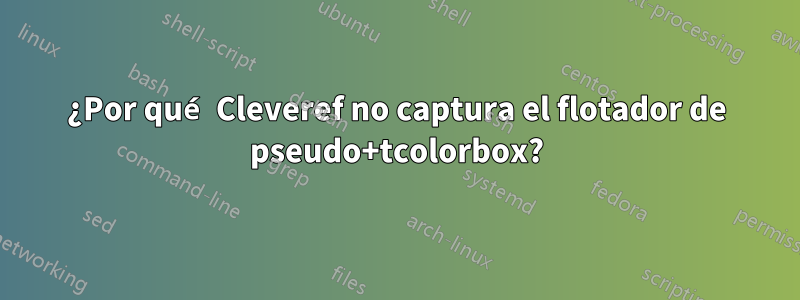
Estoy cambiando a pseudopara presentar mis algoritmos. Siguiendo la documentación, lo combiné tcolorboxpara crear un entorno flotante llamado algorithm.
Pero cuando quiero hacer referencia a él \crefdesde cleverefel paquete, el comando no puede capturar el entorno flotante relacionado con él. Por lo tanto obtengo ?? 1en lugar de alg: 1(o algo así).
Aquí hay un MWE:
\documentclass{article}
\usepackage{tcolorbox} % colored box with a lot of flexibility
\tcbuselibrary{skins,theorems} % extra lib for pseudo
\usepackage{pseudo} % for pseudocode
\newtcbtheorem{algorithm}{Algorithm}{pseudo/booktabs, float}{alg} % create a float env for algorithms
\usepackage{cleveref}
\begin{document}
\begin{algorithm}{Euclid’s algorithm, \pr{Euclid}(a, b)}{euclid}
\textbf{Input:} Two positive integers, $a$ and $b$.\\
\textbf{Output:} The greatest common divisor of $a$ and $b$.
\begin{pseudo}[label=\small\arabic*, indent-mark]
while $a \neq b$ \ct{If equal, both are gcd} \\+
if $a > b$ \ct{ Reduce max with multiple of min} \\+
$a = a - b$ \ct{ $a$ is largest} \\-
else $b = b - a$ \ct{ $b$ is largest} \\-
return $a$ \ct{ Both are gcd, so return one}
\end{pseudo}
The running time is quadratic in the number of bits in the input.
\end{algorithm}
A sentence with a clever reference \cref{alg:euclid}.
\end{document}
¿Cómo podría solucionar este problema?
Respuesta1
Simplemente configure el tipo de etiqueta para su nuevo tcolorbox con label type=algorithm:
\documentclass{article}
\usepackage{tcolorbox} % colored box with a lot of flexibility
\tcbuselibrary{skins,theorems} % extra lib for pseudo
\usepackage{pseudo} % for pseudocode
\usepackage{cleveref}
\newtcbtheorem{algorithm}{Algorithm}{label type=algorithm,pseudo/booktabs, float}{alg} % create a float env for algorithms
\begin{document}
\begin{algorithm}{Euclid’s algorithm, \pr{Euclid}(a, b)}{euclid}
\textbf{Input:} Two positive integers, $a$ and $b$.\\
\textbf{Output:} The greatest common divisor of $a$ and $b$.
\begin{pseudo}[label=\small\arabic*, indent-mark]
while $a \neq b$ \ct{If equal, both are gcd} \\+
if $a > b$ \ct{ Reduce max with multiple of min} \\+
$a = a - b$ \ct{ $a$ is largest} \\-
else $b = b - a$ \ct{ $b$ is largest} \\-
return $a$ \ct{ Both are gcd, so return one}
\end{pseudo}
The running time is quadratic in the number of bits in the input.
\end{algorithm}
A sentence with a clever reference \cref{alg:euclid}.
\end{document}
Esto es ligeramente mejor/más fácil que configurar \crefnameel contador tcb interno, como lo sugiere @egreg, ya que no necesita lidiar con el nombre del contador interno y ya lo hace \Crefnametambién, dependiendo de sus opciones de mayúsculas.
Alternativamente, si prefiere o necesita configurar crefname, puede hacerlo usando tcolorboxla opción correspondiente (este es más o menos el ejemplo del pseudomanual del usuario):
\documentclass{article}
\usepackage{tcolorbox} % colored box with a lot of flexibility
\tcbuselibrary{skins,theorems} % extra lib for pseudo
\usepackage{pseudo} % for pseudocode
\usepackage{cleveref}
\newtcbtheorem[crefname = {algorithm}{algorithms}]{algorithm}{Algorithm}{pseudo/booktabs, float}{alg} % create a float env for algorithms
\begin{document}
\begin{algorithm}{Euclid’s algorithm, \pr{Euclid}(a, b)}{euclid}
\textbf{Input:} Two positive integers, $a$ and $b$.\\
\textbf{Output:} The greatest common divisor of $a$ and $b$.
\begin{pseudo}[label=\small\arabic*, indent-mark]
while $a \neq b$ \ct{If equal, both are gcd} \\+
if $a > b$ \ct{ Reduce max with multiple of min} \\+
$a = a - b$ \ct{ $a$ is largest} \\-
else $b = b - a$ \ct{ $b$ is largest} \\-
return $a$ \ct{ Both are gcd, so return one}
\end{pseudo}
The running time is quadratic in the number of bits in the input.
\end{algorithm}
A sentence with a clever reference \cref{alg:euclid}.
\end{document}
Esto es estrictamente equivalente a la respuesta de @egreg en sus efectos, excepto que no necesita saber ni preocuparse por el nombre interno del tcolorboxcontador.
Respuesta2
Recibes la advertencia
LaTeX Warning: cref reference format for label type `tcb@cnt@algorithm'
undefined on input line 26.
Definir el formato.
Y, por favor, no pongas espacios después de los paréntesis abiertos (o antes de los cerrados) si no quieres que a tus lectores les sangren los ojos.
\documentclass{article}
\usepackage{tcolorbox} % colored box with a lot of flexibility
\tcbuselibrary{skins,theorems} % extra lib for pseudo
\usepackage{pseudo} % for pseudocode
\usepackage{cleveref}
% create a float env for algorithms
\newtcbtheorem{algorithm}{Algorithm}{pseudo/booktabs, float}{alg}
\crefname{tcb@cnt@algorithm}{algorithm}{algorithms}
\begin{document}
\begin{algorithm}{Euclid’s algorithm, \pr{Euclid}(a, b)}{euclid}
\textbf{Input:} Two positive integers, $a$ and $b$.\\
\textbf{Output:} The greatest common divisor of $a$ and $b$.
\begin{pseudo}[label=\small\arabic*, indent-mark]
while $a \neq b$ \ct{If equal, both are gcd} \\+
if $a > b$ \ct{Reduce max with multiple of min} \\+
$a = a - b$ \ct{$a$ is largest} \\-
else $b = b - a$ \ct{$b$ is largest} \\-
return $a$ \ct{Both are gcd, so return one}
\end{pseudo}
The running time is quadratic in the number of bits in the input.
\end{algorithm}
A sentence with a clever reference to \cref{alg:euclid}.
\end{document}




